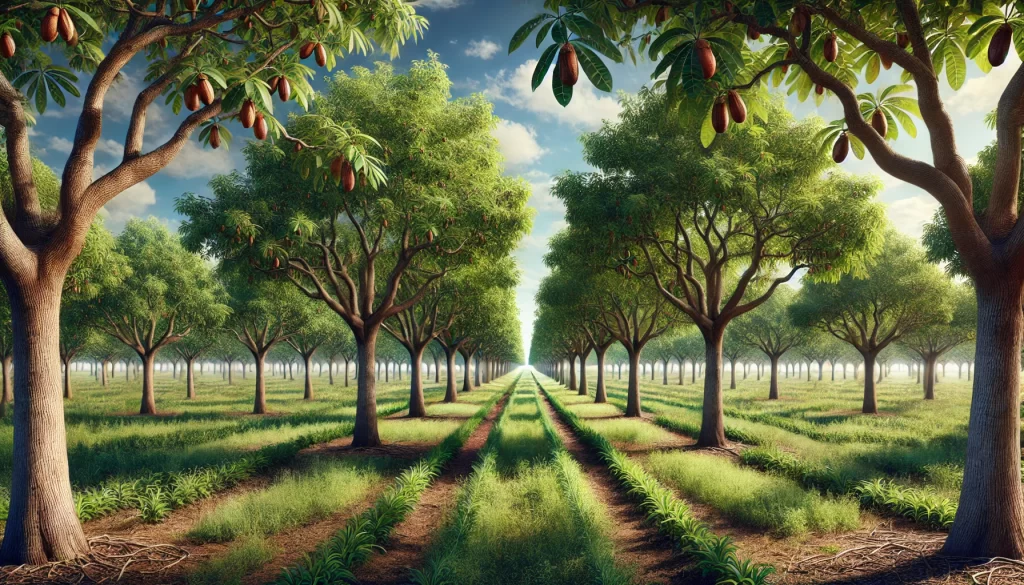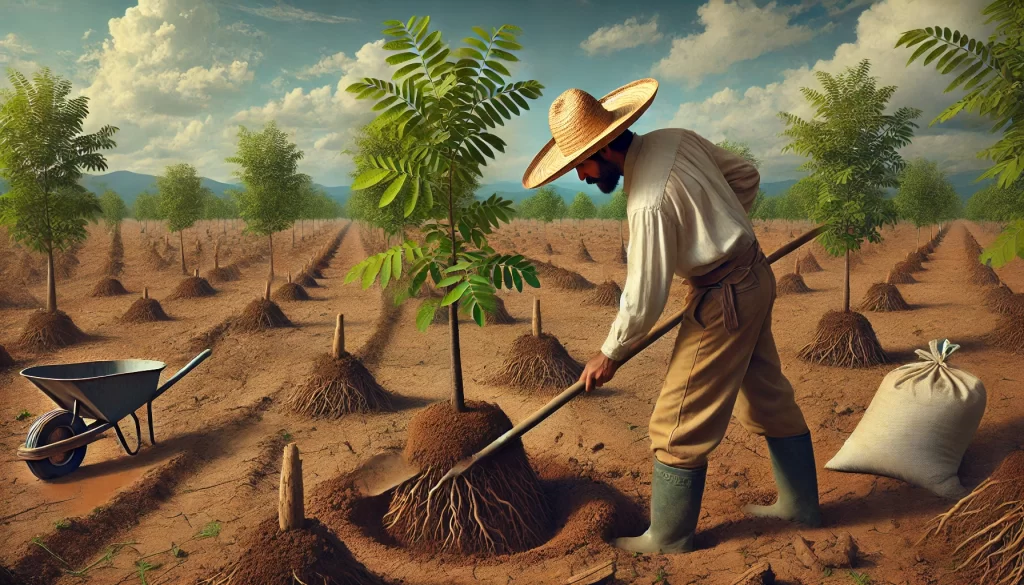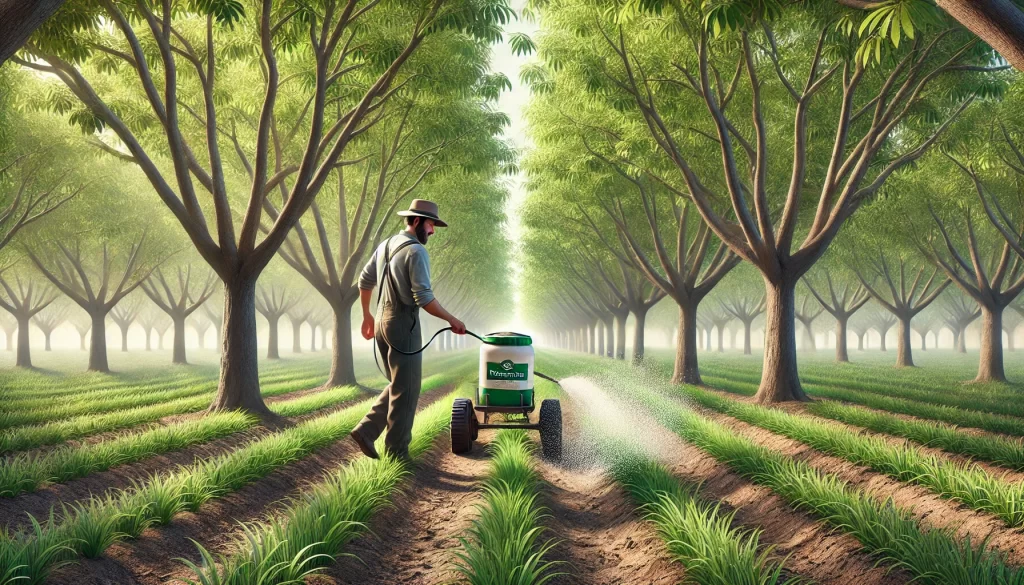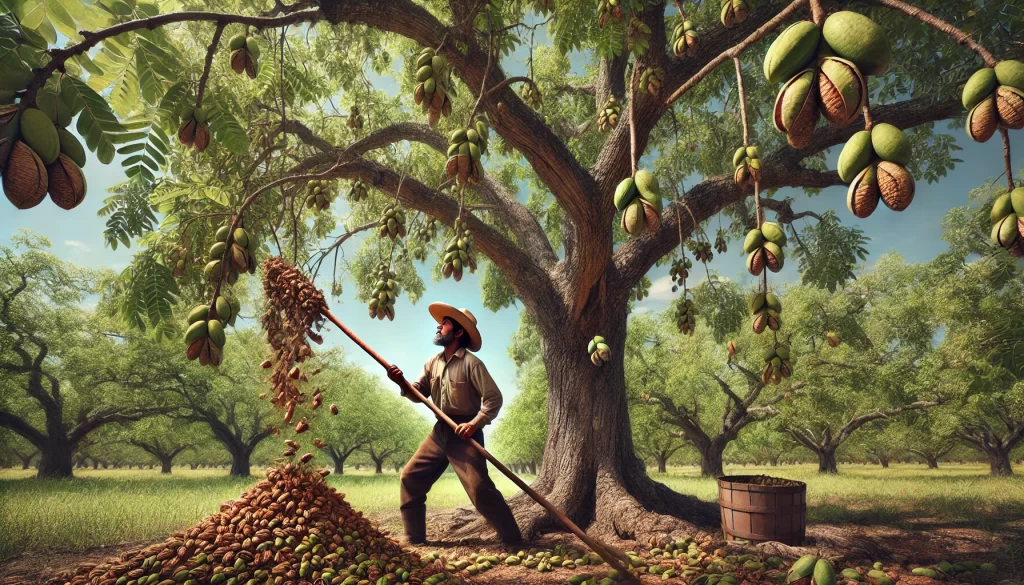Introduction to Pecan Cultivation
Pecan (Carya illinoinensis) is a fruit tree native to North America, known for its delicious nuts, which are highly valued in both gastronomy and the food industry. Pecan cultivation has gained popularity in various regions worldwide due to the high demand for its nuts and its economic potential. This article offers a comprehensive guide on pecan cultivation management, from land preparation to harvest and post-harvest management, aiming to maximize production and nut quality.

Land Selection and Soil Preparation
Ideal Climatic Conditions
Pecan trees thrive in temperate to warm climates, with cold winters that provide the necessary chilling hours to break dormancy and promote flowering. The optimal temperatures for pecan growth range between 20°C and 30°C during the growing season. It is important to select areas where late frosts are not frequent, as they can damage flowers and reduce yield.
Soil Selection
Pecan trees require deep, well-drained soils rich in organic matter. Sandy loam or loamy soils with a pH between 6.0 and 7.5 are ideal for cultivation. Avoid soils with waterlogging issues, as they can cause root diseases and affect tree development.

Soil Preparation
- Deep Tillage: Perform deep tillage to improve soil structure and promote the development of the root system.
- Organic Matter Incorporation: Add compost or well-decomposed manure to increase soil fertility and improve water retention capacity.
- pH Correction: If necessary, apply amendments to adjust soil pH and optimize growth conditions.
Pecan Tree Planting
Variety Selection
The choice of pecan variety depends on climate, soil conditions, and target market. Some of the most common varieties include:
- Western Schley: Known for its high productivity and good quality nuts, resistant to diseases.
- Pawnee: An early variety with high nut quality, suitable for regions with milder winters.
- Desirable: Very popular for its large nut size and good yield.

Propagation Methods
Pecan trees are primarily propagated by grafting or certified seedlings. Grafting is preferred in commercial production to ensure uniformity in growth and nut quality.
Pecan Tree Planting
- Spacing: A spacing of 10 to 12 meters between trees and 12 to 15 meters between rows is recommended, depending on the variety and management system.
- Planting Method: Trees should be planted in prepared holes with organic amendments, ensuring that the root system is well covered and the graft union is just above ground level.
Irrigation and Water Management
Pecan Tree Water Requirements
Irrigation is essential for pecan tree development, especially during the first years of establishment and the nut-filling phase. Water requirements vary according to the growth stage:
- Establishment: Moderate and frequent irrigation to ensure good rooting and growth of young trees.
- Vegetative Growth: Maintain consistent irrigation to promote vigorous growth and the formation of productive branches.
- Nut Development and Filling: Provide abundant irrigation during nut formation and growth to ensure good size and quality.
Irrigation Systems
- Drip Irrigation: This is the most efficient system for pecan cultivation, as it provides water directly to the root zone, minimizing evaporation losses.
- Sprinkler Irrigation: It may be suitable for large areas, but it should be managed carefully to avoid excessive wetting of foliage, which could promote disease development.

Pecan Tree Fertilization
Nutritional Requirements
Pecan is a nutrient-demanding crop, especially in nitrogen, phosphorus, and potassium. A well-balanced fertilization plan is essential to ensure vigorous growth and high-quality nut production.
- Nitrogen (N): Promotes vegetative growth and the formation of shoots and leaves.
- Phosphorus (P): Crucial for root development and fruit formation.
- Potassium (K): Improves nut quality, disease resistance, and storage capacity.
Fertilization Plan
- Base Fertilization: Apply an NPK mix before bud break to prepare the soil.
- Top-Dressing Fertilization: Apply additional nitrogen during the growth cycle, adjusting doses according to soil analysis and tree development.
- Foliar Fertilization: Use foliar applications of micronutrients, such as zinc and boron, to correct specific deficiencies and improve crop yield.

Pest and Disease Management
Common Pests
Pest management is essential to maintain the health of pecan trees and ensure the production of high-quality nuts. The most common pests include:
- Pecan Aphids: Affect young shoots and leaves, weakening the trees and reducing yield.
- Pecan Weevil (Curculio caryae): Attacks developing nuts, causing premature drops and reducing nut quality.
Control Strategies
- Regular Monitoring: Regularly inspect trees to detect pests in a timely manner.
- Biological Control: Introduce natural predators such as lacewings and parasitic wasps.
- Insecticide Application: Use specific products following technical recommendations to minimize environmental impact and avoid resistance.

Common Diseases
Diseases can significantly affect the productivity of pecan trees. The most common ones include:
- Pecan Scab (Fusicladium effusum): Causes dark spots on leaves and nuts, reducing photosynthesis and nut quality.
- Anthracnose (Glomerella cingulata): Affects leaves and fruits, causing necrotic spots that can lead to premature nut drop.
Control Strategies
- Sanitary Management: Remove parts affected by diseases to reduce spread.
- Fungicide Use: Apply preventive and curative fungicides under conditions favorable for disease development.
- Crop Rotation: Implement rotation practices and avoid continuous planting of pecan trees in the same area to reduce disease pressure.
Pruning and Tree Management
Formative Pruning
During the first years, it is crucial to perform formative pruning to develop a strong and well-distributed tree structure. Focus on removing poorly positioned, weak, or damaged branches, and promote the growth of main structural branches.

Maintenance Pruning
Maintenance pruning is carried out to remove dead, diseased, or interfering branches that obstruct air and light circulation. This practice also helps prevent the spread of diseases and facilitates harvesting.
Harvest and Post-Harvest Management
Maturity Indicators
Pecan nuts are harvested when the outer husks begin to open naturally, allowing the nuts to fall to the ground. It is important to collect the nuts quickly to avoid damage from moisture or pests.
Harvesting Techniques
Harvesting can be done manually or with mechanical equipment, such as tree shakers and ground harvesters. Manual collection is common in small orchards, while mechanization is preferable in large commercial plantations.

Post-Harvest Management
Post-harvest management is crucial to maintaining pecan nut quality. Recommended practices include:
- Drying: Dry the nuts immediately after harvest to reduce moisture content and prevent mold growth.
- Sorting and Cleaning: Sort the nuts by size and quality, and remove any impurities.
- Storage: Store the nuts in dry, cool conditions, preferably at a temperature of 0-5°C, to extend shelf life and preserve quality.
 AgronoBlog – Agriculture Blog
AgronoBlog – Agriculture Blog